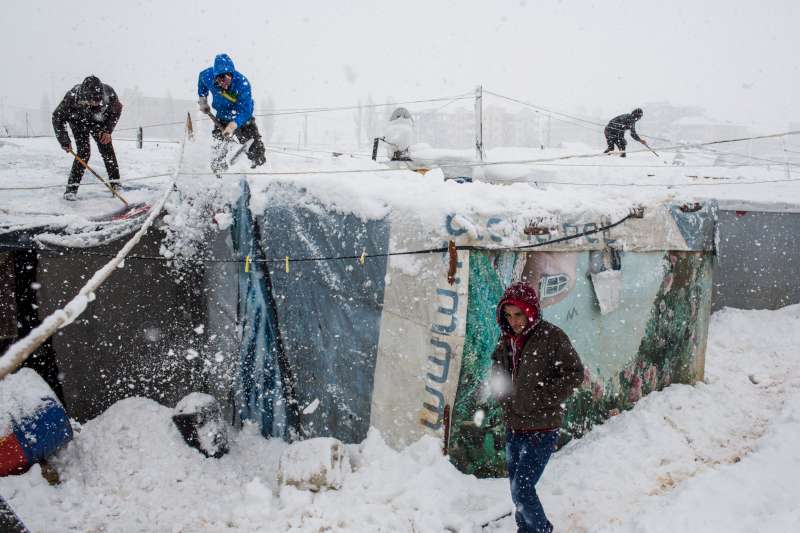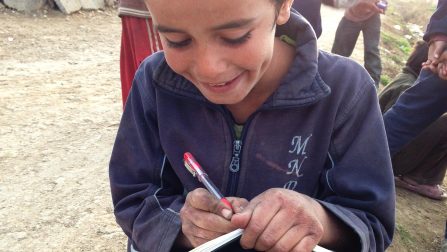War stokes further growth in forced displacement in first half 2014
The UN refugee agency on Tuesday reported that war in the Middle East, Africa and elsewhere had uprooted an estimated 5.5 million people during the first six months of 2014, signalling a further rise in the number of people forcibly displaced.
UNHCR’s new “Mid-Year Trends 2014” report shows that of the 5.5 million who were newly displaced, 1.4 million fled across international borders becoming refugees, while the rest were displaced within their own countries. Taking into account existing displaced populations, data revisions, voluntary returns and resettlement, the number of people being helped by UNHCR stood at 46.3 million as of mid-2014 – some 3.4 million more than at the end of 2013 and a record high.
Among the report’s main findings are that Syrians, for the first time, have become the largest refugee population under UNHCR’s mandate (Palestinians in the Middle East fall under the care of the UN Relief and Works Agency), overtaking Afghans, who had held that position for more than three decades. At more than 3 million as of June 2014, Syrian refugees now account for 23 per cent of all refugees being helped by UNHCR worldwide.
Despite dropping to second place, the 2.7 million Afghan refugees worldwide remain the largest protracted (at least five years) refugee population under UNHCR care. After Syria and Afghanistan, the leading countries of origin of refugees are Somalia (1.1 million), Sudan (670,000), South Sudan (509,000), the Democratic Republic of the Congo (493,000), Myanmar (480,000) and Iraq (426,000).
Pakistan, which hosts 1.6 million Afghan refugees, remains the biggest host country in absolute terms. Other countries with large refugee populations are Lebanon (1.1 million), Iran (982,000), Turkey (824,000), Jordan (737,000), Ethiopia (588,000), Kenya (537,000) and Chad (455,000).
By comparing the number of refugees to the size of a country’s population or economy, UNHCR’s report puts the contribution made by host nations into context: Relative to the sizes of their populations Lebanon and Jordan host the largest number of refugees, while relative to the sizes of their economies the burdens carried by Ethiopia and Pakistan are greatest.
In all, the number of refugees under UNHCR’s mandate reached 13 million by mid-year, the highest since 1996, while the total number of internally displaced people protected or assisted by the agency reached a new high of 26 million. As UNHCR only provides help for the internally displaced in countries where governments request its involvement, this figure does not include all internally displaced people worldwide.
“In 2014 we have seen the number of people under our care grow to unprecedented levels. As long as the international community continues to fail to find political solutions to existing conflicts and to prevent new ones from starting, we will continue to have to deal with the dramatic humanitarian consequences,” said UN High Commissioner for Refugees António Guterres.
“The economic, social and human cost of caring for refugees and the internally displaced is being borne mostly by poor communities, those who are least able to afford it. Enhanced international solidarity is a must if we want to avoid the risk of more and more vulnerable people being left without proper support.”
Another major finding in the report is the shift in the regional distribution of refugee populations. Until last year, the region hosting the largest refugee population was Asia and the Pacific. As a result of the crisis in Syria, the Middle East and North Africa have now become the regions hosting the largest number of refugees.
UNHCR’s Mid-Year Trends 2014 report is based on data from governments and the organization’s worldwide offices. As information available to UNHCR at this point in the year is incomplete it does not show total forced displacement globally (those figures are presented in June each year in UNHCR’s annual “Global Trends” report, which as of end 2013 showed that 51.2 million people were forcibly displaced worldwide). Nonetheless, the data it presents is a major component of the global total and an important indicator of worldwide refugee and IDP trends.
The full report can be downloaded here: http://unhcr.org/54aa91d89.html
Page 6 of 6
-

Syrians face desperation and danger trying to reach Greece
2 Feb 2015Eight Syrian and Palestinian men sit in an Athens basement and swap stories about their escape from the war in Syria and attempts to reach safety in Europe. Each refugee has a different tale to tell, but all share the common thread of desperation and danger faced in crossing to […]
-

Refugees caught in heavy snow as storms lash Lebanon and Jordan
9 Jan 2015Thousands of refugees across Lebanon and Jordan have been struggling to keep warm and protect their shelters this week as severe winter storms bring plummeting temperatures, heavy snow, strong winds and lashing rain to the region. UNHCR field staff say Lebanon’s Bekaa Valley was blanketed in snow on Wednesday morning, […]
-

UNHCR welcomes EU Mediterranean plans, but says more needs to be done
21 Apr 2014The UN refugee agency on Tuesday welcomed European plans to tackle the challenges of irregular migration in the Mediterranean, but said much more was needed after hundreds of refugees and migrants lost their lives on the high seas. In particular, UNHCR Assistant High Commissioner for Protection Volker Türk said in […]
In This Section

Thematic film screenings on migration
Athens, 17 September 2020 – The Greek mission of the International Organization for Migration (IOM) and UNHCR, the UN Refugee Agency, in Greece, with the support of the Municipality of Ioannina, are co-organizing a thematic cycle of film screenings. The event aims to create an open channel of communication between […]


